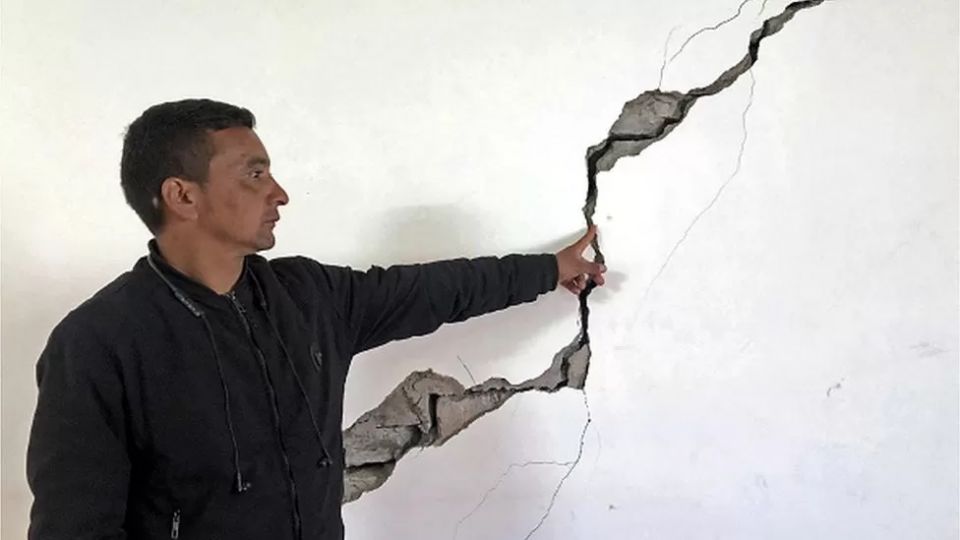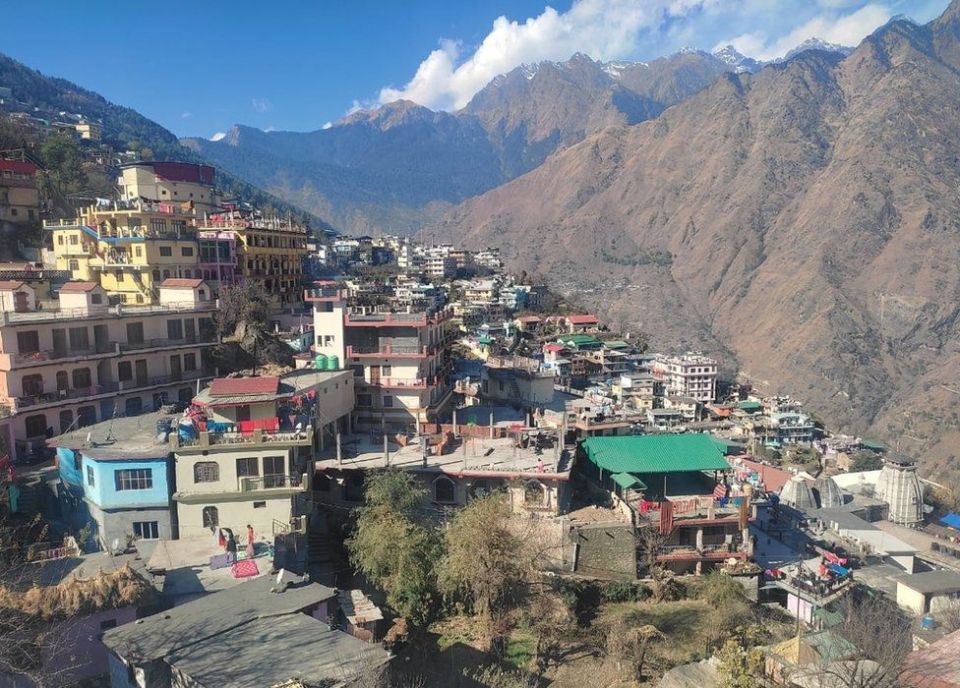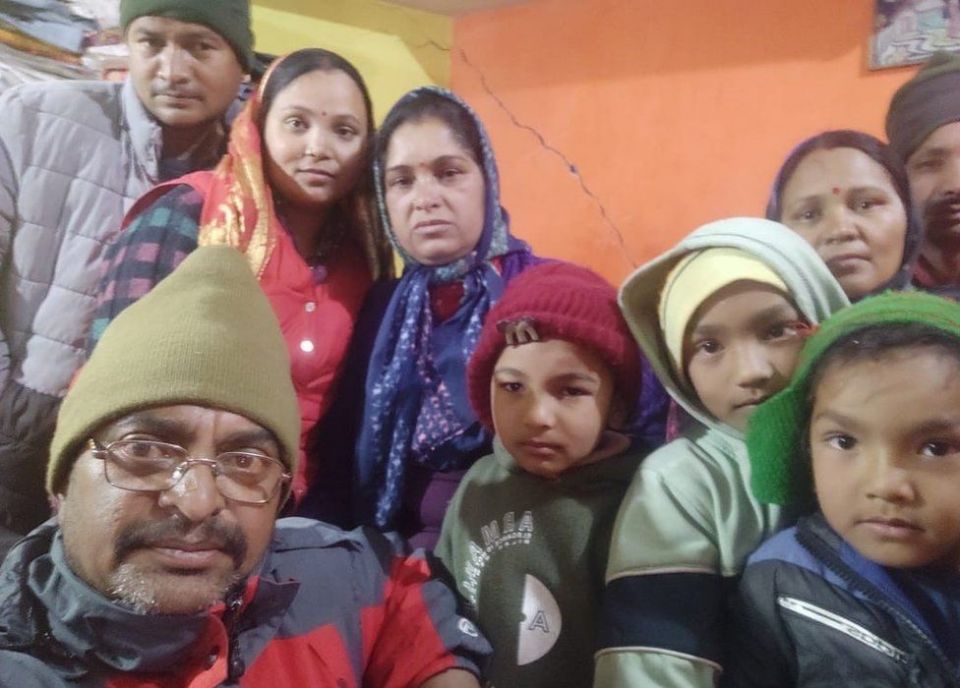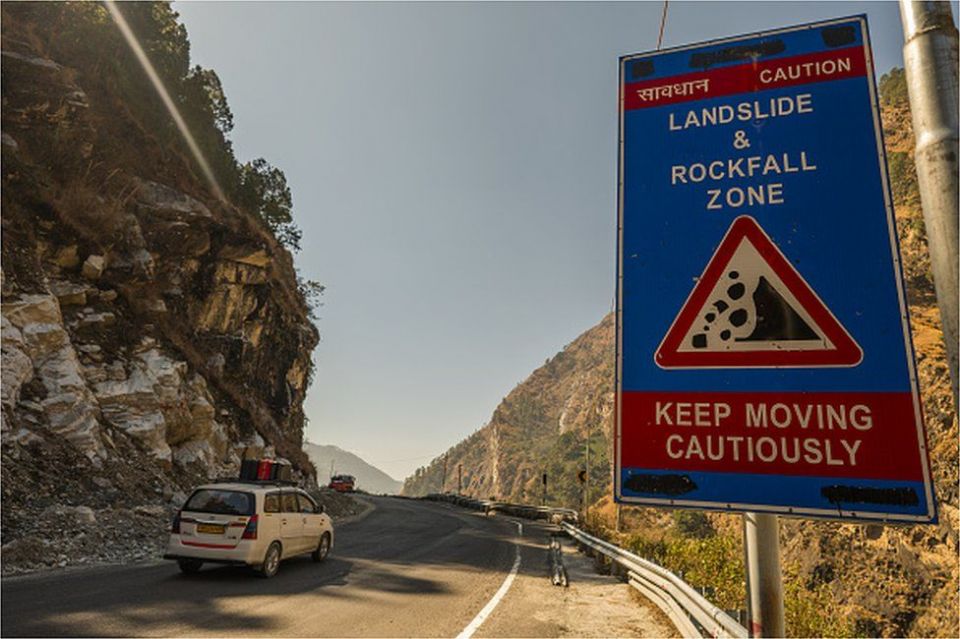
Early in the morning of 2 January, Prakash Bhotiyal woke up to a "loud sound" in his house in Joshimath, a small Himalayan mountain town in the northern Indian state of Uttarakhand.
The 52-year-old tailor switched on the lights and surveyed his newly-built, double-storey house to find gaping cracks in the brick walls in nine of the 11 rooms. The panicked 11-member extended family quickly moved to two rooms where the walls had developed only hairline cracks. They have been holed up there since then.
"We stay awake until late. A small sound creates panic. We go to bed ready to rush out in case there's an emergency," says Mr Bhotiyal.
But things aren't that safe outside either. Officials say the land is slowly sinking in Joshimath, a town of 20,000 people ensconced on a hillside where two valleys meet at an altitude of 6,151ft (1,874m).
Cracks have developed in more than 670 of some 4,500 buildings - including a local temple and a ropeway - in an area which officials say is 350m wide. There are cracks on the pavements and streets. Two hotels are now leaning on each other. Water has been gushing out of farms for reasons that are not entirely clear.
Some 80 families have been shifted from their homes to schools, hotels and homestays in the town. Disaster response teams have arrived and helicopters requisitioned for airlifting evacuees if needed. "Saving lives is our first priority," says Pushkar Singh Dhami, chief minister of Uttarakhand.

After cracks developed on the walls and floors of the squat three-room house of Durga Prasad Saklani, a 52-year-old daily wage worker, officials moved his extended family of 14 to a local hotel.
But the Saklanis return to their sinking house during the day, where they cook meals and feed their cows in the courtyard, which itself has subsided by more than two feet. In desperation, they have placed logs against the walls to stop them from caving in. Mr Saklani's wife recently had surgery in a local clinic, and the family doesn't know how she can recuperate in a cramped hotel room.
"We are watching our house crumble slowly as the cracks grow wider with every passing day. It is a horrifying sight," says Neha Saklani, a family member.
The crisis shouldn't have come as a surprise.
Joshimath itself was born in precarious geological circumstances. The town, located on the middle slope of a hill, was built on the debris of a landslide triggered by an earthquake more than a century ago, and is located in a tremor-prone zone.
Land can begin to sink for various reasons. These include the movement of the Earth's crust (its thin outer shell of rock) or due to an earthquake that can cause a shift in elevation. A sinkhole - a depression or hole in the ground caused by the collapse of the surface layer - can occur when water flowing underground erodes rocks beneath the surface.
But land also sinks due to human activity like over-extraction of groundwater and drainage of aquifers - which geologists believe may have led to the Indonesian capital, Jakarta, sinking faster than any other city in the world. More than 80% of land subsidence across the world is caused due to excessive extraction of groundwater, according to the US Geological Survey.
Human activity seems to be primarily responsible for Joshinath's woes. Over decades, a lot of water has been pumped out from beneath the ground for farming, making the sand and stone fragile. With the soil dipping, the town has been slowly sinking. "The situation is alarming," says DP Dobhal, a geologist.

As early as 1976, a government study warned that Joshimath was sinking, and recommended a ban on heavy construction work in the area. It pointed out that a lack of adequate drainage facilities was leading to landslides. "Joshimath is not suitable for a township," the study cautioned.
But the warning was not heeded. Over the decades, the place exploded into a busy gateway for hundreds of thousands of pilgrims and tourists. The pilgrims were bound for the Hindu temple town of Badrinath, some 45km (27 miles) away. Tourists trek, climb and ski in the region. Hotels, lodging houses and eateries have proliferated.
A number of hydroelectric power projects are also being built around the town. Roads have been laid and tunnels bored to improve connectivity and build infrastructure. A major concern is the Tapovan Vishnugad hydro power project whose tunnel traverses "all through the geologically fragile area below Joshimath," according to geologists MPS Bisht and Piyoosh Rautela in Disaster looms large over Joshimath, a 2010 paper published in Current Science.
In December 2009, boring equipment for the project punctured an aquifer in Joshimath, leading to a daily discharge of about 70 million litres of groundwater daily (until it was fixed), enough to sustain up to three million people, the geologists noted. (In 2021, one of two tunnels connected to the hydro power project was blocked after a huge flood in Uttarakhand, in which more than 200 people were killed and missing.)

With its valleys, gorges, hills and rivers, the mountainous state of Uttarakhand - where Joshimath is located - offers a "fragile landscape", geologists say.
The state has a long history of natural disasters. More than 1,300 people lost their lives in just five adverse events - quakes and landslides- between 1880 and 1999. Landslides, cloud bursts and flash floods claimed at least 433 lives between 2000 and 2009, according to official data. Between 2010 and 2020, 1,312 people were killed in such extreme weather events. Some 400 villages have been marked unsafe for living.
In 2021 alone, landslides, flash floods and avalanches claimed more than 300 lives in Uttarakhand, according to a study by Sushil Khanduri, a disaster management official. "These are mainly attributed to changes in the weather regime and abnormal rainfall patterns together with indiscriminate manner of human initiatives in high-risk areas," Mr Khanduri noted.
Today, Joshimath residents are on tenterhooks. How long will it take for the earth to swallow their homes? Subsidence, after all, can be a slow process. Nobody quite knows how many inches or feet the soil has been dipping over decades. There are no studies on how much the town could sink over time.
More importantly, can Joshimath be saved? A local activist quotes a top senior official as saying that as much as 40% of people living in the city would need to be evacuated if the sinking continues. "If that is true, it will be hard to save the rest of the city," says Atul Sati.










